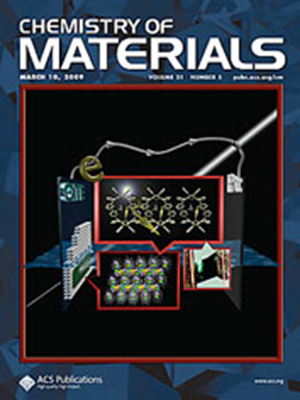晶圆级蒸发金属BiOx作为MoS2晶体管接触电极的热稳定性研究
IF 7.2
2区 材料科学
Q2 CHEMISTRY, PHYSICAL
引用次数: 0
摘要
铋是二硫化钼晶体管中应用最广泛的接触电极之一,因为它能最大限度地减少费米级钉钉和形成超低接触电阻。然而,铋触点的低熔点无疑会使其不适合高温制造工艺和应用场景。在这里,我们介绍了α-Bi2O3(一种众所周知的绝缘氧化物)的热蒸发可以形成高度金属o缺乏的BiOx相,表现出高霍尔迁移率(~ 60 cm2 V-1 s-1)和超高载流子密度(1.5 × 1015 cm-2)。详细的微观结构分析表明,晶片级蒸发bix膜具有独特的多晶Bi结构,分散在非晶bix基质中,即使加热到高于铋的熔化温度,也能保持超平坦的表面。此外,蒸发的BiOx膜被功能化为MoS2晶体管的接触电极,具有高的导通电流和650 Ω μm的超小接触电阻。更重要的是,由于具有优异的热稳定性,bix接触的MoS2晶体管在300°C退火6小时后会发生非常轻微的电衰减,而bi接触的MoS2晶体管则完全击穿。我们的研究结果表明,热蒸发的BiOx薄膜是MoS2晶体管的一种有前途的替代接触材料。本文章由计算机程序翻译,如有差异,请以英文原文为准。

Wafer-Scale Evaporated Metallic BiOx as Contact Electrodes of MoS2 Transistors with Enhanced Thermal Stability
Bismuth is one of the most widely used contact electrodes in MoS2 transistors for its capability to minimize the Fermi-level pinning and form ultralow contact resistance. However, the low melting point of bismuth contact will undoubtedly make it incompatible to a high-temperature manufactory process and application scenarios. Here, we introduce that thermal evaporation of α-Bi2O3, a well-known insulating oxide, can form a highly metallic O-deficient BiOx phase, showing a high Hall mobility (∼60 cm2 V–1 s–1) and ultrahigh carrier density (1.5 × 1015 cm–2). Detailed microstructural analysis reveals that the wafer-scale evaporated BiOx film possesses a unique structure of polycrystalline Bi dispersed within an amorphous BiOx matrix, preserving ultraflat surface even after heating above the melting temperature of bismuth. Furthermore, the evaporated BiOx film is functionalized as contact electrodes of MoS2 transistors, exhibiting a high on-state current and an ultrasmall contact resistance of 650 Ω μm. More importantly, thanks to the superior thermal stability, the BiOx-contacted MoS2 transistor undergoes very slight electrical decays after annealing at 300 °C for 6 h, while the Bi-contacted one becomes totally broken down. Our findings demonstrate thermally evaporated BiOx thin films as an alternative promising contact for MoS2 transistors.
求助全文
通过发布文献求助,成功后即可免费获取论文全文。
去求助
来源期刊

Chemistry of Materials
工程技术-材料科学:综合
CiteScore
14.10
自引率
5.80%
发文量
929
审稿时长
1.5 months
期刊介绍:
The journal Chemistry of Materials focuses on publishing original research at the intersection of materials science and chemistry. The studies published in the journal involve chemistry as a prominent component and explore topics such as the design, synthesis, characterization, processing, understanding, and application of functional or potentially functional materials. The journal covers various areas of interest, including inorganic and organic solid-state chemistry, nanomaterials, biomaterials, thin films and polymers, and composite/hybrid materials. The journal particularly seeks papers that highlight the creation or development of innovative materials with novel optical, electrical, magnetic, catalytic, or mechanical properties. It is essential that manuscripts on these topics have a primary focus on the chemistry of materials and represent a significant advancement compared to prior research. Before external reviews are sought, submitted manuscripts undergo a review process by a minimum of two editors to ensure their appropriateness for the journal and the presence of sufficient evidence of a significant advance that will be of broad interest to the materials chemistry community.
 求助内容:
求助内容: 应助结果提醒方式:
应助结果提醒方式:


